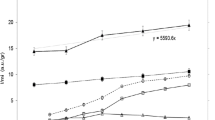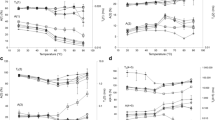Abstract
Starch is the most important energy resource in human diet, and starch is used extensively as a food ingredient to manipulate the quality of our food. In both applications, starch functionality is intimately related to its hydration level. This paper aims at elucidating the starch granule hydration by investigating genotype-specific differences for native wheat, maize, and potato starches by 1H high-resolution (HR) magic angle spinning (MAS) nuclear magnetic resonance (NMR) spectroscopy. The preparations as analyzed in D2O suspensions at room temperature provided NMR spectra with large differences in signal-to-noise (S/N) ratio ranging over several orders of magnitude. It was possible to assign a wide range of components including anomeric α-1,4 and α-1,6-protons from reducing and non-reducing ends, respectively. We utilized the effect that only mobile protons (e.g, dissolved or partially hydrated) are observed using 1H HR-MAS spectroscopy, whereas immobile protons (e.g., in water-inaccessible regions) of the starch granule are not observed due to strong homonuclear interactions to verify the hypothesis that the variations in signal intensities between the different starches are caused by genotype-specific variations in assembly of the starch granules and that the signal intensity, thus, indicates the extent of accessible granule hydration surfaces. Moreover, events taking place during thermal starch granule hydration (gelatinization) were investigated for ten representative starches. NMR spectra of suspended samples were acquired at 30, 45 and 70 °C and again after cooling at 30 °C. A substantial increase in NMR signal intensity occurs above the gelatinization temperature due to extensive proton mobilization in the starch granule assembly. The relative integrated spectral intensities at 30 °C before and after gelatinization at 70 °C showed differences in gain factors between 4 and 193. Also, 31P MAS NMR spectra displayed a similar significant intensity gain upon gelatinization. The results showed that the phosphate groups in the starch granule are mobilized concomitantly with the protons and thus deeply “buried” in the immobile (water inaccessible) domains.






Similar content being viewed by others
References
R.P. Ellis, M.P. Cochrane, M.F.B. Dale, C.M. Duffus, A. Lynn, I.M. Morrison, R.D.M. Prentice, J.S. Swanston, and S.A. Tiller, J Sci Food Agric 77, 289–311 (1998).
F. Franks, Water Relationships in Food; (Plenum Press, New York 1991), pp. 1–19.
T.A. Waigh, M.J. Gidley, B.U. Komanshek and A.M. Donald, Carbohydr Res 328, 165–176 (2000).
P.J. Jenkins, R.E. Cameron and A.M. Donald, Starch-Staerke 45, 417–420 (1993).
A. Imberty, H. Chanzy, S. Pérez, A. Buléon and V. Tran, J Mol Biol 201, 365–378 (1988).
A. Imberty and S. Pérez, Biopolymers 27, 1205–1221 (1988).
H.-C. Wu and A. Sarko, Carbohyd Res 6, 27–40 (1978).
A. Imberty, A. Buléon., V. Tran and S. Pérez, Starch/Stärke 43, 375–384 (1991).
A. Blennow, K. Houborg, R. Andersson, E. Bidzińska, K. Dyrek and M. Łabanowska, Biomacromolecules 7, 965–974 (2006).
A. Blennow, T.H. Nielsen, L. Baunsgaard, R. Mikkelsen and S.B. Engelsen, Trends Plant Sci 7, 445–450 (2002).
M.J. Gidley and S.M. Bociek, J Am Chem Soc 107, 7040–7044 (1985).
F. Horii, A. Hirai and R. Kitamaru, Macromolecules 19, 930–932 (1986).
R.P. Veregin, C.A. Fyfe, R.H. Marchessault and M.G. Taylor, Macromolecules 19, 1030–1034 (1986).
K. Kainuma and D. French, Biopolymers 11, 2241–2250 (1972).
M.J. Gidley, Carbohyd Res 139, 85–93 (1985).
D.D. McIntyre, C. Ho and H.J. Vogel, Starch/Stärke 42, 260–267 (1990).
J. Lelievre and J. Mitchell, Starch/Stärke 4, 113–115 (1975).
M.A. Glaring, K.B. Koch and A. Blennow, Biomacromolecules 7, 2310–2320 (2006).
A. Blennow, B. Wischmann and K. Houborg et al, Int J Biol Macromol 36, 159–168 (2005).
A. Bax, J Magn Reson 65, 142–145 (1985).
B. Ancian, I. Bourgeois, J.-F. Dauphin and A.A. Shaw, J Magn Reson 125, 348–354 (1997).
S.-F. Liu and K. Schmidt-Rohr, Macromolecules 34, 8416–8418 (2001).
G.S. Nilsson, K.-E. Bergquist, U. Nilsson and L. Gorton, Starch/Stärke 48, 352–357 (1996).
J.A. Creek, G.R. Ziegler and J. Runt, Biomacromolecules 7, 761–770 (2006).
F. Corzana, M.S. Motawia and C.H. du Penhoat et al, J Am Chem Soc 126, 13144–13155 (2004).
A. Blennow, K.A. Sjöland, R. Andersson and P. Kristiansson, Anal Biochem 347, 327–329 (2005).
P. Murbeck and C. Tellier, Starch/Stärke 43, 25–27 (1991).
T. Kasemsuwan and J.-L. Jane, Cereal Chem 73, 702–707 (1996).
S.B. Engelsen, A.Ø. Madsen, A. Blennow, M.S. Motawia, B.L. Møller and S. Larsen, FEBS Lett 541, 137–144 (2003).
A.M. Bay-Smidt, B. Wischmann, C.E. Olsen and T.H. Nielsen, Starch/Stärke 46, 167–172 (1994).
A. Blennow, A.M. Bay-Smidt, C.E. Olsen and B.L. Møller, Int J Biol Macromol 27, 211–218 (2000).
C.G. Oates, Trends Food Sci Technol 8, 375–382 (1997).
Acknowledgment
Per Lassen Nielsen and Karen Houborg are acknowledged for their technical assistance. Maize starch was a kind gift from AKV Langholt, Denmark (Cargill), and the normal potato starch was kindly provided by KMC Amba, Denmark. The amylopectin potato starch was a kind gift for Lyckeby Stärkelsen, Sweden. Dr Bente Wischmann, The Pajbjerg Foundation, and Sejet Plant Breeding, Denmark and Semper AB, Sweden are thanked for providing the wheat starches. A.B. acknowledges The Danish National Research Foundation, The Danish Biotechnology Program, The Danish Directorate for Development (Centre for Development of Improved Food Starches), and The Committee for Research and Development of the Øresund Region (Øforsk) for financial support. F.H.L. and S.B.E. wish to thank the Danish Dairy Foundation, the Danish Directorate for Fisheries and Agro Business (FSK 03-5), and the Danish Research Councils for generous support to our Bromatonomics project (the use of quantitative NMR in Danish dairy and food science). Prof. Niels Chr. Nielsen and Dr. Morten Bjerring at Laboratory for Biomolecular NMR Spectroscopy, Department of Chemistry, University of Aarhus, Denmark are gratefully acknowledged for acquisition of the 13C MAS and CP/MAS data.
Author information
Authors and Affiliations
Corresponding author
Rights and permissions
About this article
Cite this article
Larsen, F.H., Blennow, A. & Engelsen, S.B. Starch Granule Hydration—A MAS NMR Investigation. Food Biophysics 3, 25–32 (2008). https://doi.org/10.1007/s11483-007-9045-4
Received:
Accepted:
Published:
Issue Date:
DOI: https://doi.org/10.1007/s11483-007-9045-4




